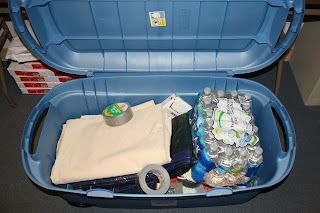I received a reminder this week that the
G8 Summit will be taking place shortly at Camp David. The NMCWM is located within driving distance from
that location. So the good news is that
we may get a few more visitors. However,
it has also been pointed out that these summits do sometimes attract protesters, and
that sometimes they are not the peaceful kind.
We were all reminded to review the museum’s Emergency Plan. We hope we won’t need to use any part of the
plan, but it doesn’t hurt to review the procedures so that we will be prepared
for whatever might happen.
The Emergency Plan covers a number of
potential threats including fires and floods, power outages, weather issues,
earthquakes, bomb threats, robberies, as well as civil disturbances. The plan designates the people in charge, the
emergency numbers to call, and the procedures to follow in order to assure the
safety of the staff and visitors to the museum.
 |
| The museum also keeps first aid kits on each floor of the building. They are monitored and restocked regularly by a designated staff member. |
It is always wise to have a plan and some
basic supplies in place for unexpected situations. Knowing the proper procedures and having some
basic supplies will enable people to better handle the emergency, and could
even save lives. This is true for your
own home and family as well. I’ll go
just a bit off topic here and point out that it isn’t difficult to obtain and
fill a plastic tub or two with some first aid and emergency supplies for your
family.
 |
| You never know what might happen. Several years ago this car actually hit the side of our museum building! Fortunately, no one was seriously injured. |
Though the safety of the people in the
museum building is the first consideration, we also have supplies and procedures
in place to ensure the safety of the museum’s exhibits and collection.
I hope we never have to deal with a fire,
flood, or any other emergency situation.
However, it’s good to know that we have procedures in place to deal with
them, that we are prepared with supplies, and that we have emergency resources
identified in case we do need them.
*Note – Ironically,
the fire alarm went off a few minutes after I finished this post! It was not a drill. The museum staff quickly cleared the building
and accounted for everyone. Within a
couple of minutes the fire trucks had arrived.
The firemen discovered that the alarm had gone off in response to a
small amount of smoke in the elevator control room. It turned out that a pump in the museum’s
elevator had overheated. I was very
relieved to learn that the smoke had been contained and hadn’t affected the
artifacts!
 |
| Staff members Adele, Katie, Kent, and Tom (with Sawyer) waiting at the appointed meeting place for the “all clear” announcement. |
 |
| Frederick’s finest firemen at work! |
It appears that I picked the correct week to cover Emergency Preparedness!
Photos courtesy of the National Museum of Civil War Medicine.




No comments:
Post a Comment